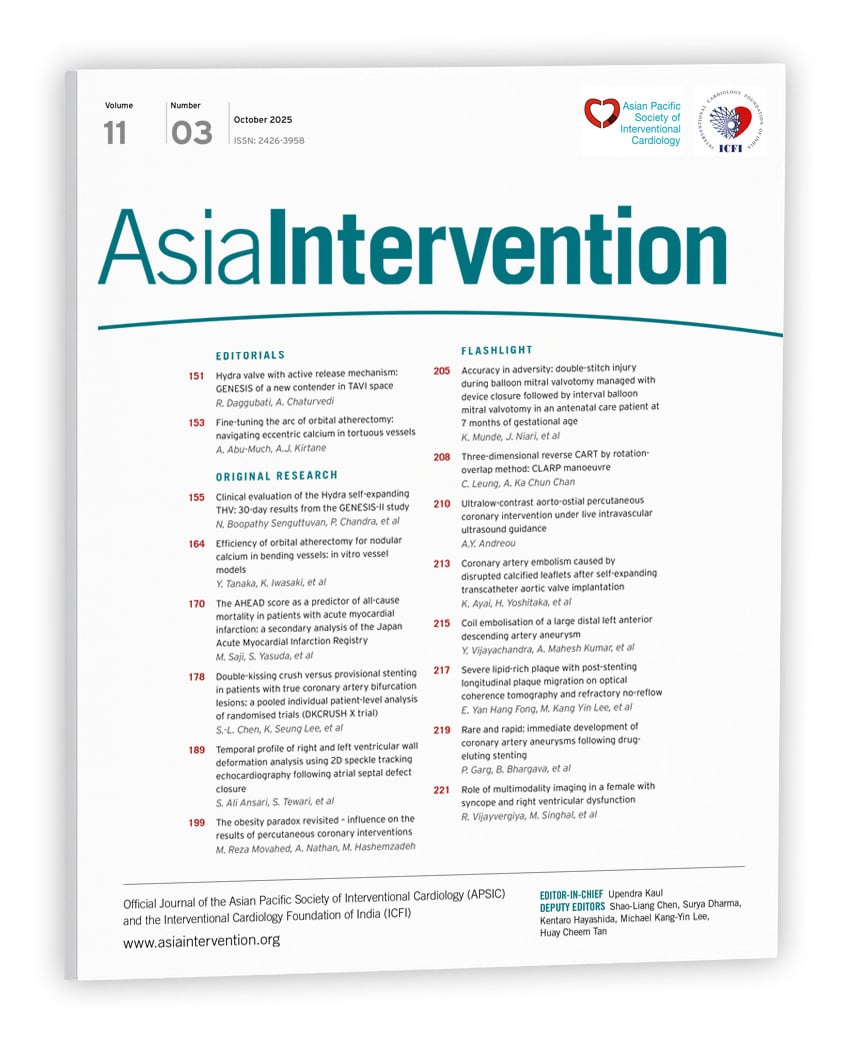Transcatheter aortic valve implantation (TAVI) technology has evolved over time from a therapy initially reserved for inoperable patients to a guideline-recommended treatment for severe aortic stenosis (AS) across all surgical risk profiles and age groups1. As TAVI volumes and operator experience rise, iterative device developments have contributed to an improved safety profile, enhanced valve performance, and a reduced risk of periprocedural complications23. However, no single TAVI device can be considered one-size-fits-all, as current-generation transcatheter heart valves (THVs) continue to face challenges with regard to commissural misalignment, coronary reaccess, paravalvular leak (PVL), and conduction disturbances – highlighting the ongoing need for innovation and real-world validation4. The Hydra THV (Vascular Innovations; a subsidiary of Sahajanand Medical Technologies) is a self-expanding, supra-annular bioprosthetic valve with a nitinol frame and bovine pericardial leaflets; it is currently approved in Europe and several Asian countries. Hydra’s first-in-human study (n=15, high-risk) showed favourable 30-day outcomes with an effective orifice area (EOA) of 1.53 cm2, a mean aortic gradient (AG) of 9 mmHg, moderate-severe PVL in 7.7% of patients, new permanent pacemaker implantation (PPI) in 14.3%, and no strokes5.The GENESIS study (n=40, high-risk) reported 92.5% device success, an EOA of 2.2 cm2, a mean AG of 7.6 mmHg, no moderate-severe PVL, new PPI in 7.5%, no strokes, and an all-cause mortality rate of 17.5% at 6 months6. In the Hydra CE study (n=157, high-extreme risk), device success was 94.3% with improved haemodynamics (EOA 1.9 cm2; mean AG 8.1 mmHg), PVL in 6.3-6.9% of cases, new PPI in 11.7-12.4%, 0.6% strokes, and a mortality rate of 7.0-14.6% at 30 days and 1 year, respectively7. In this issue of AsiaIntervention, Senguttuvan et al report results from the GENESIS-II study evaluating the next-generation Hydra THV. This device features an active release mechanism for controlled tentacle deployment and precise implantation − a key advancement over earlier iterations8. The study enrolled 40 high-risk symptomatic AS patients across 19 sites in India. Device success was achieved in 95% of cases, with improved haemodynamics (EOA 1.9 cm2, mean AG 8.4 mmHg) and favourable 30-day outcomes: no moderate-severe PVL, new PPI in 7.9%, no strokes/major bleeding/vascular complication, improvement of ≥1 New York Heart Association Class in 73.7% of patients, an increase in the 6-minute walk distance from 217 m to 275 m, and a low cardiovascular mortality rate of 2.5%. One intraprocedural death occurred during predilatation, and one patient required surgical reintervention for device embolisation. The current study highlights some unique strengths of the latest Hydra THV. Its high device success rate and favourable haemodynamics are on par with other commercially available self-expanding THVs. The low PPI rates (7.9%) compared to Navitor (Abbott; â¼15%), Evolut PRO (Medtronic; â¼20.7%), and ACURATE neo2 (Boston Scientific; â¼8.1%) are presumed to be due to the Hydra’s non-flared inflow and lower radial force design. What makes this more intriguing is the concomitant absence of >mild PVL despite no outer skirt and a lower inflow radial strength. It is, however, unclear why almost half the cohort (47.5%) in the study needed post-dilatation. Notably, PVL rates (7.7% in the first-in-human study, 0% in GENESIS, 6.3% in Hydra CE, and 0% in GENESIS-II) and PPI rates (14.3%, 7.5%, 11.7%, and 7.9%, respectively) have fluctuated across studies using the Hydra valve without a clear trend, indicating that factors beyond valve design, implantation technique, and operator experience may be at play. These observations warrant deeper mechanistic investigation and prospective validation. Stroke rates across Hydra studies were only 0-0.6% despite frequent predilatation and no embolic protection. However, limited data on valvular calcium and stroke assessment during follow-up restrict one’s understanding of these findings. Although no major vascular complications were reported, Hydra’s 18 Fr delivery profile for all valve sizes may not be attractive to many operators, underscoring the need to evaluate smaller (e.g., 14 Fr) sheath compatibility to remain competitive with contemporary THVs. Lastly, despite its open-cell design, coronary obstruction was reported in two patients in the Hydra CE study, raising concerns about leaflet height and commissural alignment – issues yet to be addressed by ongoing Hydra studies. The Hydra THV is a thoughtfully engineered, next-generation valve with encouraging early outcomes and design features aimed at improving safety and precision. Its flexible delivery system, differential radial force, and repositionability make it particularly promising for patients with complex aortic anatomies, as well as those at risk of conduction abnormalities and patient-prosthesis mismatch. While results from the GENESIS-II study are promising, larger real-world, post-marketing, head-to-head comparative studies with long-term follow-up data are essential to fully establish this new contender’s safety, durability, and clinical value in the contemporary “crowded” TAVI landscape.
Conflict of interest statement
The authors have no conflicts of interest to declare.

